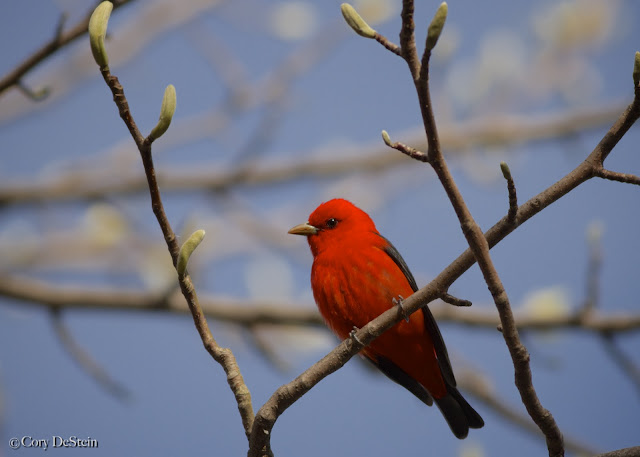By Cory DeStein
Hi everybody! My name is Cory DeStein, I am a birder from Pittsburgh, Pennsylvania. I have joined Cory and Luke here as the newest contributor to Boom. Unlike these guys, I actually do not work in the bird field, I am a nurse at a pediatric hospital in Pittsburgh. I bird strictly for hobby! My goal is to be able to share with you all my birding adventures in Pennsylvania, birding trips through out the country, photography, and my amusing adventures with attempting to increase my yard list.
 |
| Kentucky Warbler along Dunbar Creek. |
I started the morning off along Dunbar Creek, the drive in was loaded with Kentucky Warblers, Louisiana Waterthrush, Worm-eating Warblers and Wood Thrush. From the parking area I picked up plenty of Magnolia Warblers, Song Sparrow, House Wren, as well as a Great-blue Heron fishing in the creek. Working my way up the ridge through the hemlocks I caught sight of a Swainson's Thrush lurking in the underbrush. Climbing up the ridge I continued to enjoy plenty of Worm-eating Warblers as well as Northern Parula singing from the eastern hemlocks.
 |
| Worm-eating Warbler |
At the mid-way point up the mountain you come to a clearing with multiple food plots, fruit trees, and dense underbrush. This has worked out to be one of the better migrant traps I have come across here. Kentucky Warblers continued to call in all directions as well as Louisiana Waterthrush. A Wilson's Warbler popped up from the brush along with the White-crowned and White-throated Sparrows. Red-breasted Nuthatches were calling from the larches a bird I have never had breeding here, but appears that this year they are. Accompanying the nuthatches in the trees were at least 5 Rose-breasted Grosbeaks feeding with the males singing up a storm. Carefully checking the fruit trees I was able to add Magnolia, Nashville, Tennessee, Hooded, Black-and-white, and Black-throated Green Warblers to my day list as well as a nearby singing Winter Wren.
 |
| 1 of 5 Rose-breasted Grosbeaks in a single tree! |
Conquering the final stretch of the climb to the flats I was able to grab Blue-headed, Red-eyed, Yellow-throated and Warbling Vireos as well as Ovenbirds calling non-stop. Upon reaching the top of the ridge I could hear Yellow-billed Cuckoo calling, but it was hot as hell and I wasn't going to go looking for it. Covering just a short distance along the access road the growth along the path was filled with Indigo Buntings, Chestnut sided and Hooded Warblers with plenty of Field and Chipping Sparrows adding to the mix before I ventured back down to my car. I ended today with 62 species during my hike and reached 97 species for SGL 51 this year.
 |
| Chestnut-sided Warbler were EVERYWHERE |
 |
| The most cooperative Winter Wren |
 |
| Scarlet Tanager |
I hope everyone enjoyed this introduction to me as well as spring birding in Fayette County, I hope to be able to add more from this area (like when I find a Swainson's Warbler!!) and much more! Thanks for reading!

You may have many goshawk nesting areas near where you live. I have been a resident of Williamsport, Pa., and i discovered that NG were nesting on a hillside, of which the base of the hill was only 400 yards from my huge apartment complex in the suburbs. I was told that NG were nesting in 6 areas near the city, that from a Master falconer. North central PA is loaded with the goshawk! Please heed- THE MAN WHO SAW TOO MANY GOSHAWKS- ebook available from www.smashwords.com. The best- Nelson Briefer- Anacortes, WA. www.goshawkspugetsound.blogspot.com.
ReplyDelete